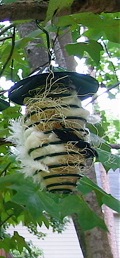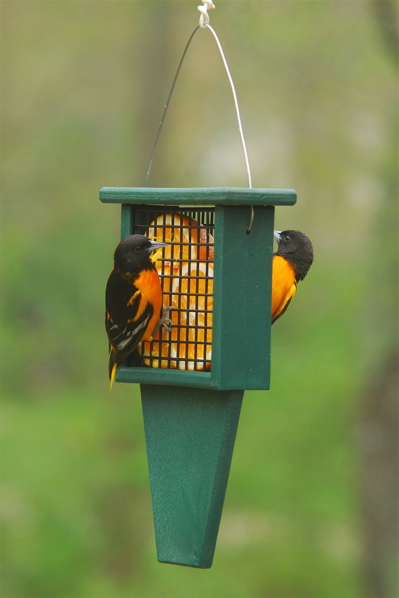-
fun squirrel feeders go recycled and large capacity too
Yes, some of us do feed the squirrels! Some just for fun and the entertainment aspect, others feed them as a deterrent from bird feeders, keeping them occupied. And some, well they just despise the little critters. After all they are a member of the rodent family, but for some reason, the bushy tail seems to make them okay?
The Table & Chair Feeder is a classic that’s been around forever, and they last for years until the wood starts to crack and rot from exposure to the elements. Now this fun feeder has gone green, as in recycled plastic. It won’t crack, fade, split or warp… guaranteed! The best thing about recycled plastic anything, is that it helps keeps these plastics out of landfills. Some products come with stickers telling you how many milk jugs, or containers were used to manufacture the item, which is pretty cool. These fun squirrel feeders are made to last, chew-proof and handsome too, the little critters will love them. As a special treat during frigid weather, we smear peanut butter on the corn cobs… they go crazy for it! The high fat & protein content provides the extra calories needed for energy to stay warm, and it tastes good too.
But if one single corn cob isn’t enough for your pack, the large capacity stalk
feeder might be in order. These are perfect for corn cobs (and fruit too in summer). Attract orioles, cat birds, woodpeckers and other migratory friends with orange slices, apples or grapes during warm weather. These squirrel feeders hold lots of corn (12 ears), but if your furry friend, little pigs are like ours… no amount of food ever seems to be enough!
Hey… and thanks for feeding the squirrels 🙂
- Bird Accessories, Bird Nesting Materials, Fruit Bird Feeder, Nesting Material, Suet Feeders, Uncategorized
be ready for the season with homemade nesting materials
The cold weather of winter leaves behind some clues for us (if we look) from the previous busy season of the avian world. Simply look up and take notice. Barren-looking trees with their foliage stripped will reveal the nests of several species, and what they’ve used for nesting materials.
Large, messy nests are usually the work of squirrels, while a smaller nest consisting of twigs and grasses may be that of a Cardinal, Blue Jay, or Mockingbird. An even smaller nest with tightly woven plant fibers, maybe even some milkweed or thistle down still attached would be the work of an American Goldfinch. You’d have to search a bit harder to find nests from Bluebirds, Chickadees, or Nuthatches, as these birds nest in cavities or birdhouses. You can easily encourage nest building around your place this season by offering nesting materials before the season actually starts. Although there are many cool kinds of materials and holders available, this is most definitely a “do-it-yourselfer”!
Start by gathering nesting materials now. Feathers and pet hair are preferred by Chickadees, while decorative mosses (Spanish, Sphagnum, and that thin, curly straw-like stuff) might be used by many species mentioned above. Bright cotton yarns add a nice touch too, as variety is the spice of life. Although I’ve always heard that dryer lint is a good one… our local birds have never touched it when previously offered. Stay away from plastics, fishing line, and the like. These can get tangled around nestlings or their legs, proving to be hazardous, and sometimes fatal.
Now, what to put your nesting materials in? That part is simple! A standard suet cage works perfectly, as do the mesh produce bags from the grocery store (the kind apples come in). The
Spring Feeder shown here is just that, meant for fruit or suet. We’ve found whole peanuts and our nesting materials work great in them too. Talk about versatility! Put a mixture of materials in several holders and hang them from branches around your yard where the birds will see them. Do pull some materials through to get started, but don’t pack them in too tightly. Birds need to be able to pull them out fairly easily, and should the rain saturate the nesting material, it will dry quickly if air can flow through it. So start gathering… and here’s to many successful broods this season!
- Bird Accessories, Bird Feeders, Fruit Bird Feeder, Nesting Material, Peanut Feeders, Recycled Bird Feeders, Suet Feeders
Hold your nuts in all kinds of peanut bird feeders!
Attract many kinds of birds… and squirrels too if you don’t add a baffle to peanut bird feeders! Wood Peckers, Nuthatches and Blue Jays especially love whole peanuts in the shell, and there are so many cool ways to offer up this wild bird delicacy. There are lots of peanut bird feeders available for shelled peanuts too if you’d rather not contend with the ground waste, and birds like them equally as well. The wreath feeder shown here makes a fun peanut feeder, fruit feeder, or even a nesting material container in spring.
A plain old suet cage or basket is a great way to offer peanuts. These cages, whether double, single, inexpensive, or quality recycled plastic make perfect peanut bird feeders. They’re terrific for offering nesting materials in spring, and work wonderfully for serving fruit in summer to attract migratory birds. Now that’s versatility! Even if you don’t feed suet to your birds, the cage-like design makes them perfect for year round use. In fact, this recycled plastic double suet feeder is actually deemed a three-in-one feeder-for suet, peanuts, or fruit.
This suet feeder has Orioles chowing down on oranges in summer, but you can attract a wide variety of feathered friends year round with suet feeders used for peanuts, nesting material, and oh yeah… suet too!







